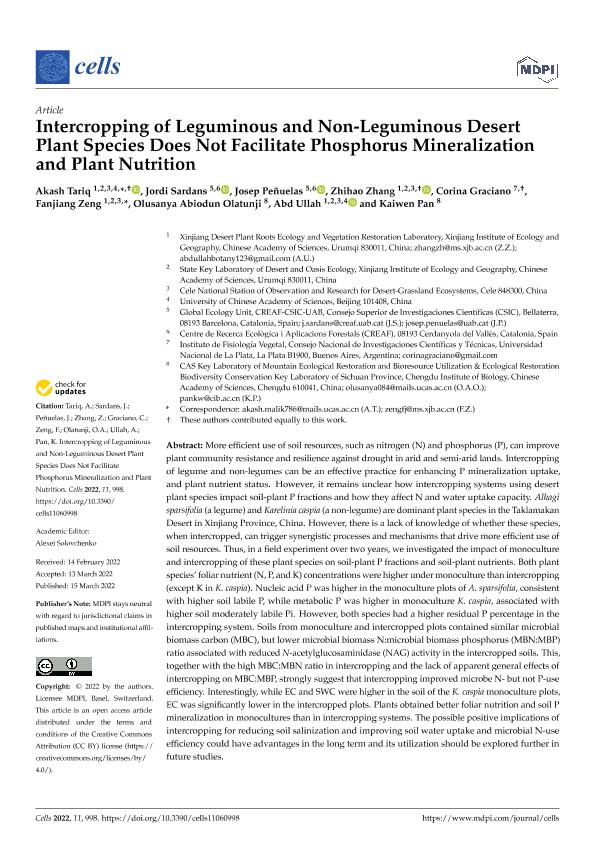Artículo
Intercropping of Leguminous and Non-Leguminous Desert Plant Species Does Not Facilitate Phosphorus Mineralization and Plant Nutrition
Tariq, Akash; Sardans, Jordi; Peñuelas, Josep; Zhang, Zhihao; Graciano, Corina ; Zeng, Fanjiang; Olatunji, Olusanya Abiodun; Ullah, Abd; Pan, Kaiwen
; Zeng, Fanjiang; Olatunji, Olusanya Abiodun; Ullah, Abd; Pan, Kaiwen
 ; Zeng, Fanjiang; Olatunji, Olusanya Abiodun; Ullah, Abd; Pan, Kaiwen
; Zeng, Fanjiang; Olatunji, Olusanya Abiodun; Ullah, Abd; Pan, Kaiwen
Fecha de publicación:
03/2022
Editorial:
MDPI
Revista:
Cells
ISSN:
2073-4409
Idioma:
Inglés
Tipo de recurso:
Artículo publicado
Clasificación temática:
Resumen
More efficient use of soil resources, such as nitrogen (N) and phosphorus (P), can improve plant community resistance and resilience against drought in arid and semi-arid lands. Intercropping of legume and non-legumes can be an effective practice for enhancing P mineralization uptake, and plant nutrient status. However, it remains unclear how intercropping systems using desert plant species impact soil-plant P fractions and how they affect N and water uptake capacity. Alhagi sparsifolia (a legume) and Karelinia caspia (a non-legume) are dominant plant species in the Taklamakan Desert in Xinjiang Province, China. However, there is a lack of knowledge of whether these species, when intercropped, can trigger synergistic processes and mechanisms that drive more efficient use of soil resources. Thus, in a field experiment over two years, we investigated the impact of monoculture and intercropping of these plant species on soil-plant P fractions and soil-plant nutrients. Both plant species’ foliar nutrient (N, P, and K) concentrations were higher under monoculture than intercropping (except K in K. caspia). Nucleic acid P was higher in the monoculture plots of A. sparsifolia, consistent with higher soil labile P, while metabolic P was higher in monoculture K. caspia, associated with higher soil moderately labile Pi. However, both species had a higher residual P percentage in the intercropping system. Soils from monoculture and intercropped plots contained similar microbial biomass carbon (MBC), but lower microbial biomass N:microbial biomass phosphorus (MBN:MBP) ratio associated with reduced N-acetylglucosaminidase (NAG) activity in the intercropped soils. This, together with the high MBC:MBN ratio in intercropping and the lack of apparent general effects of intercropping on MBC:MBP, strongly suggest that intercropping improved microbe N-but not P-use efficiency. Interestingly, while EC and SWC were higher in the soil of the K. caspia monoculture plots, EC was significantly lower in the intercropped plots. Plants obtained better foliar nutrition and soil P mineralization in monocultures than in intercropping systems. The possible positive implications of intercropping for reducing soil salinization and improving soil water uptake and microbial N-use efficiency could have advantages in the long term and its utilization should be explored further in future studies.
Palabras clave:
ARIDITY
,
COMPETITION
,
DROUGHT
,
NITROGEN
,
NITROGEN FIXATION
,
PHOSPHORUS
Archivos asociados
Licencia
Identificadores
Colecciones
Articulos(INFIVE)
Articulos de INST.DE FISIOLOGIA VEGETAL
Articulos de INST.DE FISIOLOGIA VEGETAL
Citación
Tariq, Akash; Sardans, Jordi; Peñuelas, Josep; Zhang, Zhihao; Graciano, Corina; et al.; Intercropping of Leguminous and Non-Leguminous Desert Plant Species Does Not Facilitate Phosphorus Mineralization and Plant Nutrition; MDPI; Cells; 11; 6; 3-2022; 1-23
Compartir
Altmétricas



